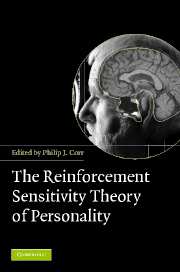Book contents
- Frontmatter
- Contents
- List of abbreviations
- List of figures
- List of tables
- List of contributors
- Preface
- 1 Reinforcement Sensitivity Theory (RST): introduction
- 2 The neuropsychology of fear and anxiety: a foundation for Reinforcement Sensitivity Theory
- 3 Animal cognition and human personality
- 4 The behavioural activation system: challenges and opportunities
- 5 Reinforcement Sensitivity Theory and personality
- 6 Reinforcement sensitivity scales
- 7 Performance and conditioning studies
- 8 Psychophysiological studies
- 9 Reinforcement Sensitivity Theory and mood induction studies
- 10 Neuro-imaging and genetics
- 11 Reinforcement Sensitivity Theory and psychosomatic medicine
- 12 RST and clinical disorders: anxiety and depression
- 13 RST and psychopathy: associations between psychopathy and the behavioral activation and inhibition systems
- 14 Behavioural activation and inhibition in social adjustment
- 15 Reinforcement sensitivity in the workplace: BIS/BAS in business
- 16 Formal and computational models of Reinforcement Sensitivity Theory
- 17 Reinforcement Sensitivity Theory: a critique from cognitive science
- 18 The contribution of Reinforcement Sensitivity Theory to personality theory
- General Index
- Index of Names
- References
13 - RST and psychopathy: associations between psychopathy and the behavioral activation and inhibition systems
Published online by Cambridge University Press: 31 January 2011
- Frontmatter
- Contents
- List of abbreviations
- List of figures
- List of tables
- List of contributors
- Preface
- 1 Reinforcement Sensitivity Theory (RST): introduction
- 2 The neuropsychology of fear and anxiety: a foundation for Reinforcement Sensitivity Theory
- 3 Animal cognition and human personality
- 4 The behavioural activation system: challenges and opportunities
- 5 Reinforcement Sensitivity Theory and personality
- 6 Reinforcement sensitivity scales
- 7 Performance and conditioning studies
- 8 Psychophysiological studies
- 9 Reinforcement Sensitivity Theory and mood induction studies
- 10 Neuro-imaging and genetics
- 11 Reinforcement Sensitivity Theory and psychosomatic medicine
- 12 RST and clinical disorders: anxiety and depression
- 13 RST and psychopathy: associations between psychopathy and the behavioral activation and inhibition systems
- 14 Behavioural activation and inhibition in social adjustment
- 15 Reinforcement sensitivity in the workplace: BIS/BAS in business
- 16 Formal and computational models of Reinforcement Sensitivity Theory
- 17 Reinforcement Sensitivity Theory: a critique from cognitive science
- 18 The contribution of Reinforcement Sensitivity Theory to personality theory
- General Index
- Index of Names
- References
Summary
We review the experimental evidence regarding information processing anomalies that have been observed in psychopaths, and conclude that the body of evidence is in substantially better accord with the revised Reinforcement Sensitivity Theory (RST), and, in particular, the current conceptualization of the BIS, than with the original version of RST. In addition, clear associations exist between psychopathy and self-report measures of the BAS and BIS constructs, and we discuss possible explanations for those associations that merit evaluation in future psychopathy research.
RST and psychopathy: associations between psychopathy and the BAS and BIS
Maladaptive behavior that is anti-social or impulsive in nature has been characterized as reflecting disinhibition – a decreased ability to regulate response inclinations in light of possible adverse consequences (e.g., Gorenstein and Newman 1980). Due to psychopaths' penchant for engaging in anti-social, maladaptive behavior, psychopathy is a prototypical example of the clinical syndromes that have disinhibited behavior as a prominent feature. For instance, although psychopaths make up only 1 per cent of the general population, they constitute 15 to 25 per cent of the prison population (Hare 1996), and psychopathic offenders are two to five times more likely to re-offend than are non-psychopaths (Hemphill, Hare and Wong 1998; Quinsey, Rice and Harris 1995; Serin 1996; Walters 2003).
- Type
- Chapter
- Information
- The Reinforcement Sensitivity Theory of Personality , pp. 398 - 414Publisher: Cambridge University PressPrint publication year: 2008
References
- 10
- Cited by



